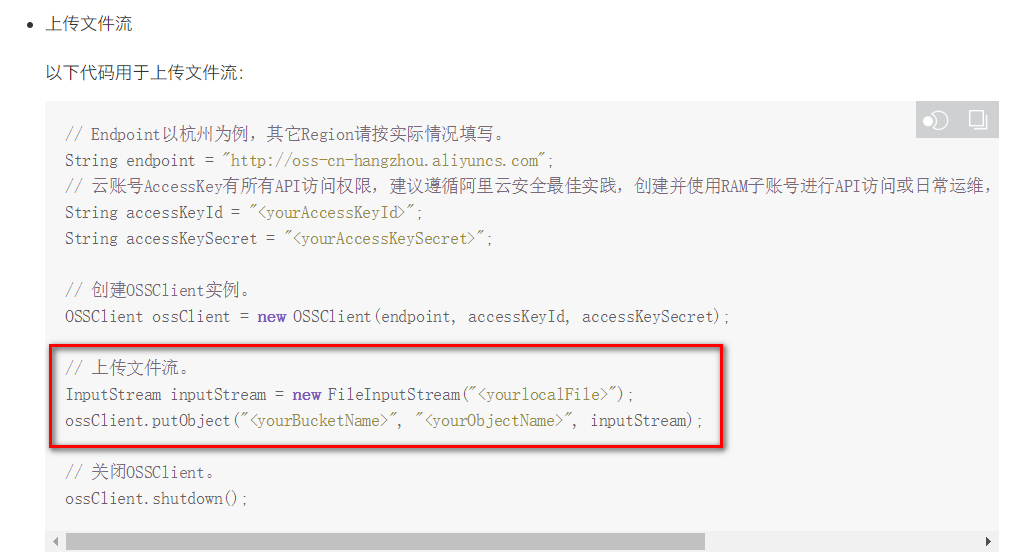一、新建云存储微服务
1、在service模块下创建子模块service-oss
2、配置pom.xml
service-oss上级模块service已经引入service的公共依赖,所以service-oss模块只需引入阿里云oss相关依赖即可,
service父模块已经引入了service-base模块,所以Swagger相关默认已经引入
<dependencies><!-- 阿里云oss依赖 --><dependency><groupId>com.aliyun.oss</groupId><artifactId>aliyun-sdk-oss</artifactId></dependency><!-- 日期工具栏依赖 --><dependency><groupId>joda-time</groupId><artifactId>joda-time</artifactId></dependency></dependencies>
3、配置application.properties
#服务端口server.port=8002#服务名spring.application.name=service-oss#环境设置:dev、test、prodspring.profiles.active=dev#阿里云 OSS#不同的服务器,地址不同aliyun.oss.file.endpoint=your endpointaliyun.oss.file.keyid=your accessKeyIdaliyun.oss.file.keysecret=your accessKeySecret#bucket可以在控制台创建,也可以使用java代码创建aliyun.oss.file.bucketname=guli-file
4、logback-spring.xml
5、创建启动类
创建OssApplication.java
package com.guli.oss;@SpringBootApplication@ComponentScan({"com.atguigu"})public class OssApplication {public static void main(String[] args) {SpringApplication.run(OssApplication.class, args);}}
6、启动项目
报错 Spring boot 会默认加载org.springframework.boot.autoconfigure.jdbc.DataSourceAutoConfiguration这个类,
Spring boot 会默认加载org.springframework.boot.autoconfigure.jdbc.DataSourceAutoConfiguration这个类,
而DataSourceAutoConfiguration类使用了@Configuration注解向spring注入了dataSource bean,又因为项目(oss模块)中并没有关于dataSource相关的配置信息,所以当spring创建dataSource bean时因缺少相关的信息就会报错。
解决办法:
方法1、在@SpringBootApplication注解上加上exclude,解除自动加载DataSourceAutoConfiguration
@SpringBootApplication(exclude = DataSourceAutoConfiguration.class)
二、实现文件上传
1、从配置文件读取常量
创建常量读取工具类:ConstantPropertiesUtil.java
使用@Value读取application.properties里的配置内容
用spring的 InitializingBean 的 afterPropertiesSet 来初始化配置信息,这个方法将在所有的属性被初始化后调用。
/*** 常量类,读取配置文件application.properties中的配置*/@Component//@PropertySource("classpath:application.properties")public class ConstantPropertiesUtil implements InitializingBean {@Value("${aliyun.oss.file.endpoint}")private String endpoint;@Value("${aliyun.oss.file.keyid}")private String keyId;@Value("${aliyun.oss.file.keysecret}")private String keySecret;@Value("${aliyun.oss.file.filehost}")private String fileHost;@Value("${aliyun.oss.file.bucketname}")private String bucketName;public static String END_POINT;public static String ACCESS_KEY_ID;public static String ACCESS_KEY_SECRET;public static String BUCKET_NAME;public static String FILE_HOST ;@Overridepublic void afterPropertiesSet() throws Exception {END_POINT = endpoint;ACCESS_KEY_ID = keyId;ACCESS_KEY_SECRET = keySecret;BUCKET_NAME = bucketName;FILE_HOST = fileHost;}}
2、文件上传
1)创建Service接口:FileService.java
public interface FileService {/*** 文件上传至阿里云* @param file* @return*/String upload(MultipartFile file);}
2)实现:FileServiceImpl.java
参考SDK中的:Java->上传文件->简单上传->流式上传->上传文件流
public class FileServiceImpl implements FileService {@Overridepublic String upload(MultipartFile file) {//获取阿里云存储相关常量String endPoint = ConstantPropertiesUtil.END_POINT;String accessKeyId = ConstantPropertiesUtil.ACCESS_KEY_ID;String accessKeySecret = ConstantPropertiesUtil.ACCESS_KEY_SECRET;String bucketName = ConstantPropertiesUtil.BUCKET_NAME;String fileHost = ConstantPropertiesUtil.FILE_HOST;String uploadUrl = null;try {//判断oss实例是否存在:如果不存在则创建,如果存在则获取OSSClient ossClient = new OSSClient(endPoint, accessKeyId, accessKeySecret);if (!ossClient.doesBucketExist(bucketName)) {//创建bucketossClient.createBucket(bucketName);//设置oss实例的访问权限:公共读ossClient.setBucketAcl(bucketName, CannedAccessControlList.PublicRead);}//获取上传文件流InputStream inputStream = file.getInputStream();//构建日期路径:avatar/2019/02/26/文件名String filePath = new DateTime().toString("yyyy/MM/dd");//文件名:uuid.扩展名String original = file.getOriginalFilename();String fileName = UUID.randomUUID().toString();String fileType = original.substring(original.lastIndexOf("."));String newName = fileName + fileType;String fileUrl = fileHost + "/" + filePath + "/" + newName;//文件上传至阿里云ossClient.putObject(bucketName, fileUrl, inputStream);// 关闭OSSClient。ossClient.shutdown();//获取url地址uploadUrl = "http://" + bucketName + "." + endPoint + "/" + fileUrl;} catch (IOException e) {throw new GuliException(ResultCodeEnum.FILE_UPLOAD_ERROR);}return uploadUrl;}}
3)控制层controller
创建controller:FileUploadController.java
package com.guli.oss.controller;@Api(description="阿里云文件管理")@CrossOrigin //跨域@RestController@RequestMapping("/admin/oss/file")public class FileController {@Autowiredprivate FileService fileService;/*** 文件上传** @param file*/@ApiOperation(value = "文件上传")@PostMapping("upload")public R upload(@ApiParam(name = "file", value = "文件", required = true)@RequestParam("file") MultipartFile file) {String uploadUrl = fileService.upload(file);//返回r对象return R.ok().message("文件上传成功").data("url", uploadUrl);}}
4、重启oss服务
5、Swagger中测试文件上传
6、配置nginx反向代理
将接口地址加入nginx配置
location ~ /eduoss/ {proxy_pass http://localhost:8001;}


